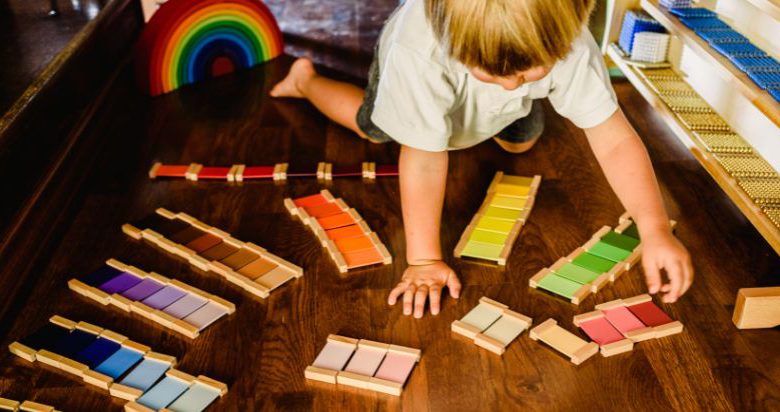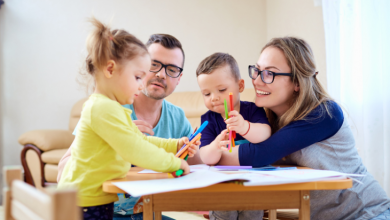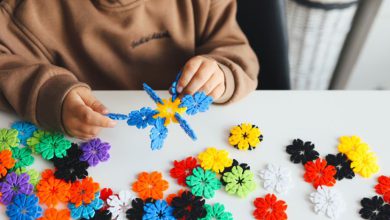Play-Based Learning

Play-Based Learning
The words “play” and “learning” don’t get used enough in the same sentence — especially since they work so well together! Even though a traditional classroom is what most people think of when they think about school, there’s no reason that play-based learning can’t be a part of the discovery process. Play-based learning has amazing benefits that every classroom can harness and use to cultivate the minds of tomorrow.
What Is Play-Based Learning?
Play-based learning is just what it sounds like — it’s learning while you play!
Too easy, right? Let’s define what play is. Researchers see play-based learning in two distinct ways.
- Free Play: This is when play is an adult-free zone. Educational experts define free play as “…child-directed, voluntary, internally motivated, and pleasurable.” An easy example is playing “House” and everyone has a role in the family (mom, dad, sister, brother, pet cat, random squirrel that lives in the attic).
- Guided Play: This is when a teacher is either guiding the play or involved in it at some level. Guided play generally has two levels: Teacher-directed and mutually-directed.
- Teacher-directed play happens any time a teacher takes the role of conductor.
- An example of mutually-directed play would be a teacher listening to their students making up lyrics to a song and then suggesting they all write one together. In essence, the kids are steering the bus, but the teacher is pumping the breaks.
The other thing we need to define is learning. What is it that’s being learned exactly? Experts look at how play affects developmental learning and academic learning.
- Developmental learning involves understanding things like social etiquette, problem-solving, leading and following rules, and developing empathy for others. This kind of learning is seen most during free play.
- Academic learning is what people think of most when they hear the word “learning.” Learning how to read and how to count would be considered academic and (not surprisingly) it tends to be teacher-directed or mutually-directed in terms of how play is involved.
Why Is Play-Based Learning Important?
What makes play-based learning an important concept and not just a nice idea? Is there actual proof that play is important?
The answer is a resounding yes!
The LEGO Foundation teamed up with UNICEF on a massive study that looked at the importance of play-based learning, specifically in early-childhood education programs. Here are the high points of what they found.
- Play is one of the most important ways that kids under the age of 8 gain essential knowledge and skills.
- Children learn critical skills and develop as they play.
- There is often a lack of understanding (both by parents and teachers) of just how valuable play is in creating a foundation for academic concepts.
- Play-based learning should happen in the classroom, but it can’t stop there. Play-learning should happen at home and in a child’s community, too.
The last big reason that play is important is because it bridges the gap between free play and teacher-guided play in a classroom.
- Child-directed activities (free play) are on one end.
- Teacher-directed play (learning through games) falls at the other end.
- Mutually-directed play (collaboratively designed play) falls in the middle.
With play-based learning, all of the benefits that come from different kinds of play and learning can be a part of a child’s classroom experience. Children can let their imaginations and passions guide them for a time, teachers can address certain topics formally, and everyone can work together to find new ways to think about big concepts.
Unfortunately, when it comes to academic learning, play is often dismissed altogether. Teachers use what’s called “direct instruction,” which is the more traditional method of children sitting and listening to a teacher talk about a subject. For topics like science, reading, and math, play is oftentimes considered to be ineffective and a distraction.
But research is showing the exact opposite.
- One study found that guided play was more effective than direct instruction at teaching young children basic math skills.
- One group of researchers found teachers who used a play-based literacy curriculum watched their students use new words more frequently than children who were taught using direct instruction.
- There is very little arguing over the immense value that free play has when it comes to developing the cognitive and social-emotional skills kids need to be successful in the future.
Reggio Emilia Approach & Play-Based Learning
Little Sunshine’s Playhouse is guided by the Reggio Emilia Philosophy of education. And even if you only know a little about Reggio Emilia, you’ve probably already noticed that play-based learning fits perfectly into our way of doing things.
In fact, most of the principles of Reggio Emilia are directly supported by play-based learning.
- Children are capable of constructing their own learning. Children are the main initiators of their own learning process and should be treated as active collaborators in their education, as opposed to passive observers.
- Children are collaborators and learn through interaction within their communities. Learning is based on relationships across all spectrums of learning. In Reggio Emilia there is a close interaction between teachers, parents, and children.
- Children are natural communicators and should be encouraged to express themselves however they feel they can. Children learn through words, movement, drawings, paintings, buildings, sculptures, and more.
- The classroom environment acts as the third teacher. Children thrive in welcoming, aesthetically pleasing environments that are suited to their interests and developmental stages. The layout of the classroom promotes relationships, communication, collaboration, and exploration through play.
- Teachers are partners, nurturers, and guides who help facilitate the exploration of children’s interests. Teachers guide experiences, discovery, and problem solving. A teacher listens and observes the children, as well as questions and looks for opportunities to encourage further exploration of a child’s interests.
Little Sunshine’s also follows what’s known as an emergent curriculum. Emergent curriculum is a teaching approach that adapts to the unique interests of the students rather than following a strict, predetermined syllabus or lesson plan. Teachers at Little Sunshine’s are given the freedom to take the interests of their students and the environment around them to create learning opportunities.
Here’s an example of what that looks like in action. Let’s say your little one has recently become enamored with the moon. If their teacher heard about this new interest, they could:
- Use the circle shape of a full moon to inspire the class’s art time.
- Play a game where students take turns pretending to be the moon and running around a stationary object (or person!) who represents Earth.
- Count the number of moons that different planets have.
- Read books about space travel.
- Act out a make-believe story about a group of children traveling to the moon and what they find there.
None of this was planned, but one simple interest can unlock so many opportunities to learn about so many different kinds of things. The same is true for play-based learning. If kids learn best while at play, why not try to attach as many learning opportunities to play as possible?
Examples of Play-Based Learning
There are SO many play-based learning options that teachers can incorporate into their daily routines. Here are just a few examples.
- An obstacle course
- Sensory art
- Anything involving music
- Imaginary play, both in a group and students on their own
- Teachers and parents may need to give a “prompt” to get things started. (“Let’s pretend we’re astronauts!” “Let’s pretend we’re wild animals!” or “Let’s pretend we’re deep-sea divers!”)
- Mixing water dyed with primary colors to make secondary ones
- Playing “doctor” with stuffed animals to practice caretaking, problem-solving, etc.
- Playing “supermarket” and using items in the class to count, follow instructions, etc.
The list goes on and on!
As a parent, play-based learning gives you the chance to customize playtime for each of your children. Ask yourself these questions to come up with your own play-based-learning activities.
- What activities are your kids the most drawn to?
- What do they spend the longest time doing?
- Are there any positive social dynamics they are expressing that you want to encourage?
- Are there negative social dynamics they are expressing that you want to address?
For parents, Little Sunshine’s Playhouse provides regular at-home activities that are fun for the whole family. They’re posted on our website and social media frequently, so make sure to take a look!
Play Hard & Learn
Play is a natural part of being a kid. And parents and teachers alike shouldn’t be too quick to dismiss play and instead assign homework or only use direct instruction in the classroom.
Little Sunshine’s Playhouse believes in the power of play, and we get the privilege of watching it transform little minds every day. Especially in their early childhood years, make sure that a healthy dose of play is a part of your child’s academic life.





